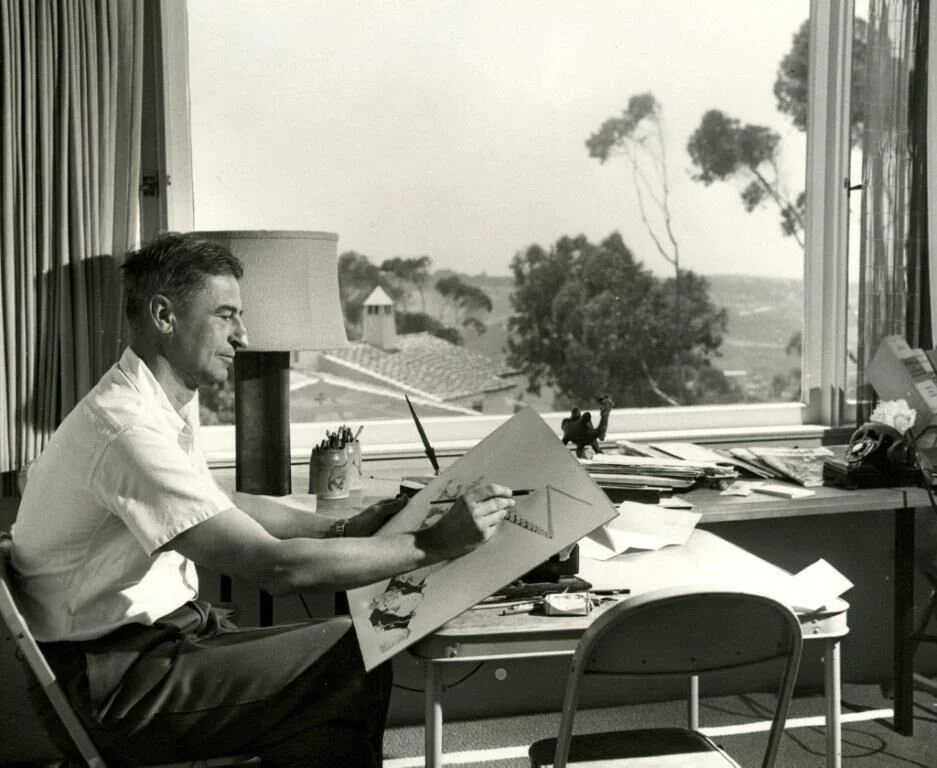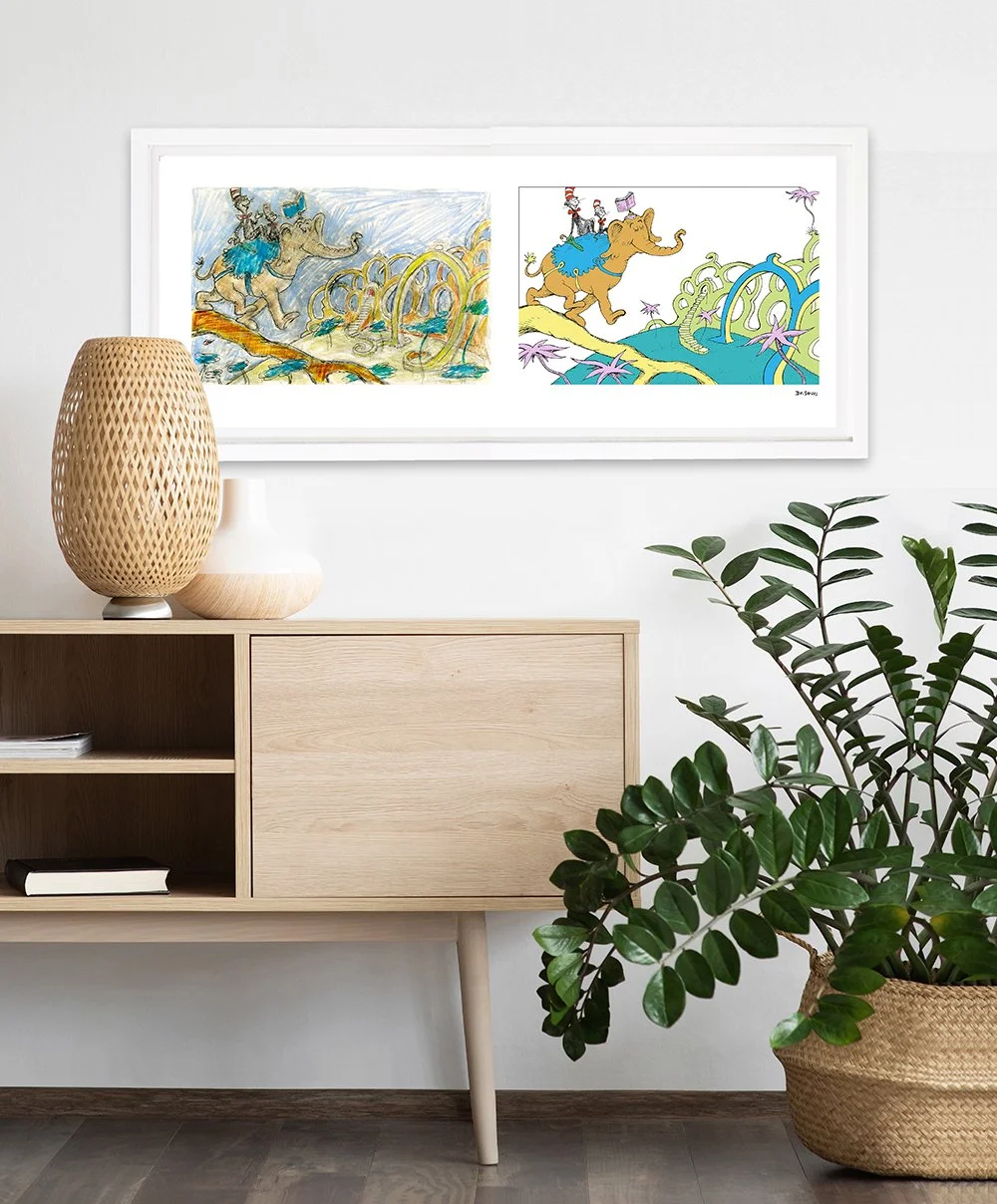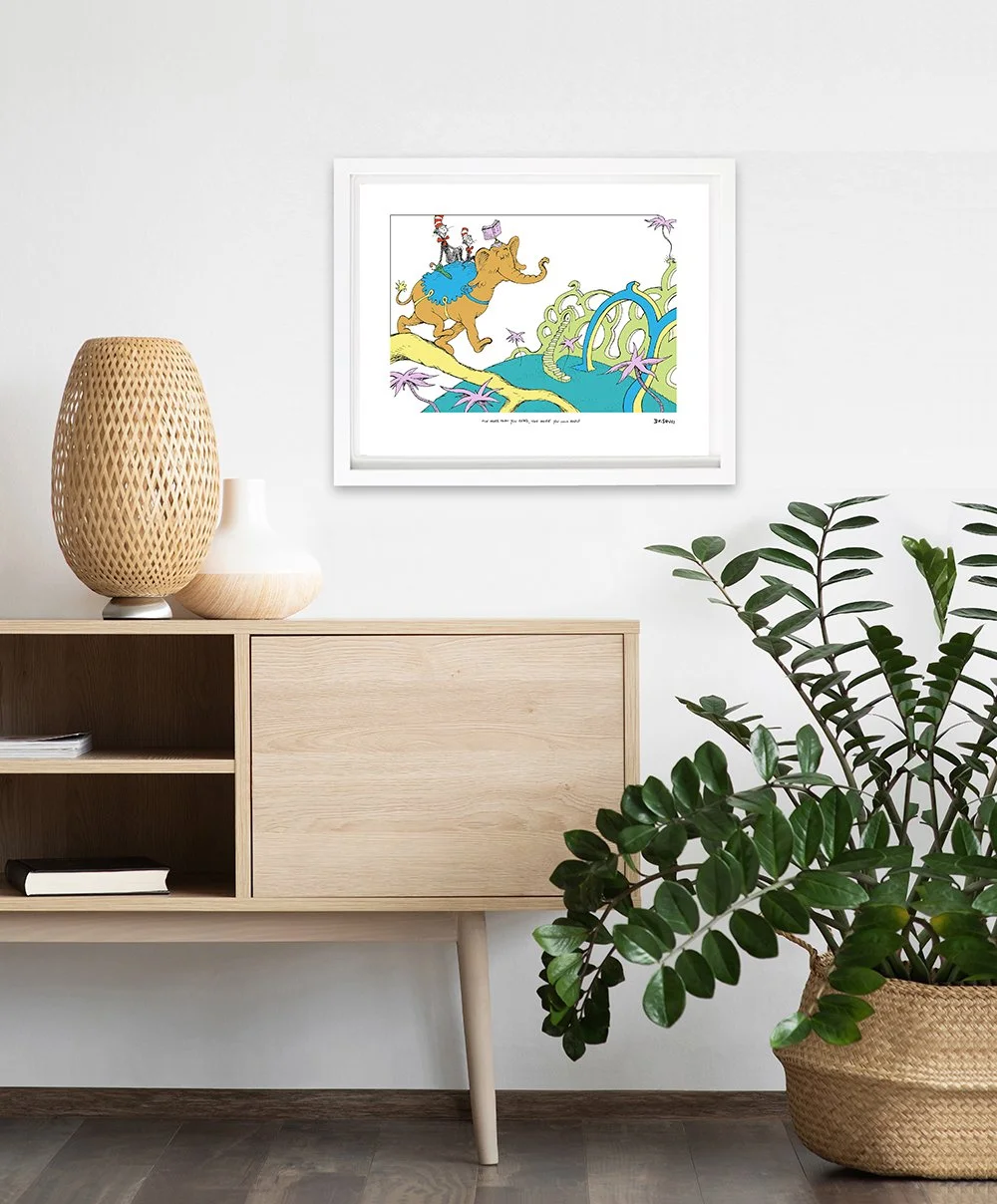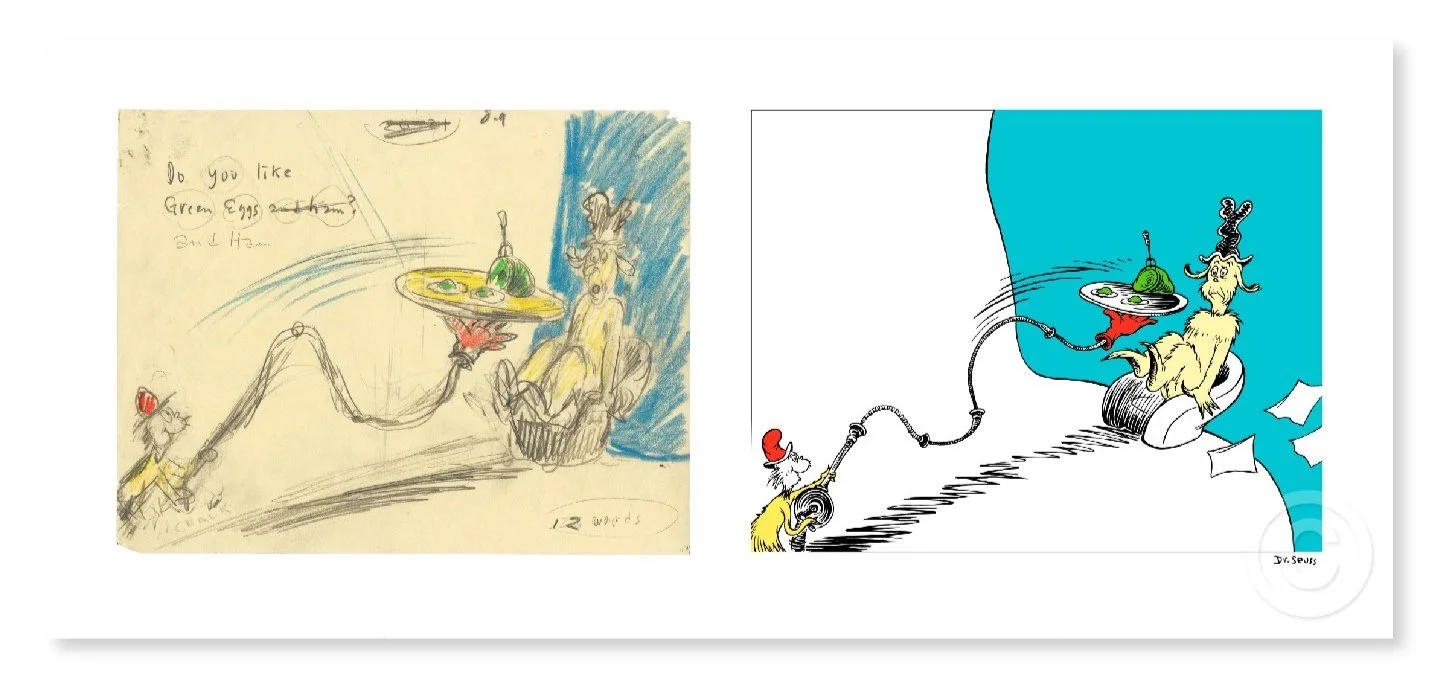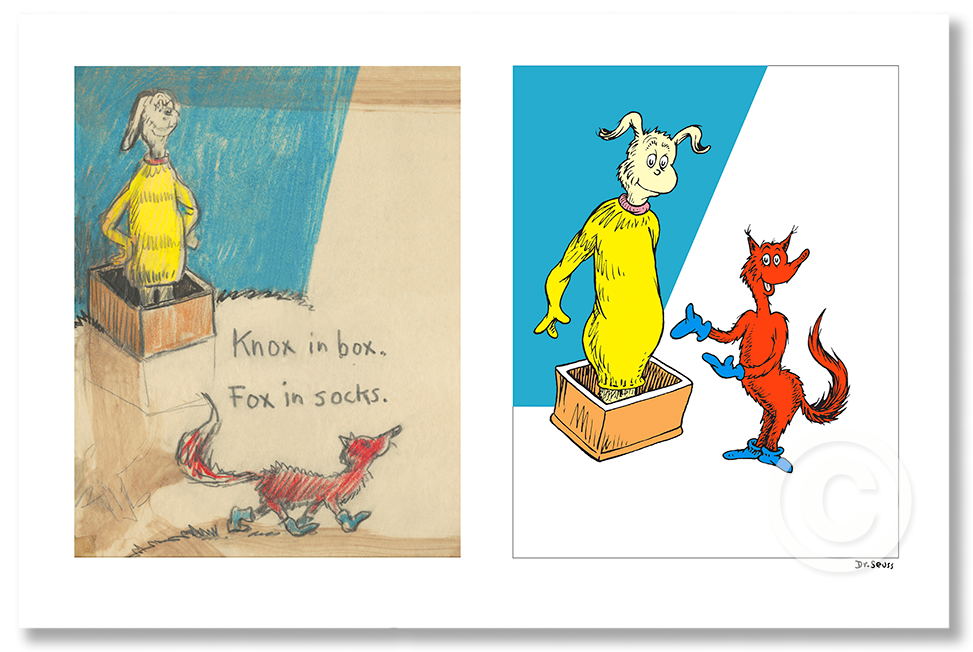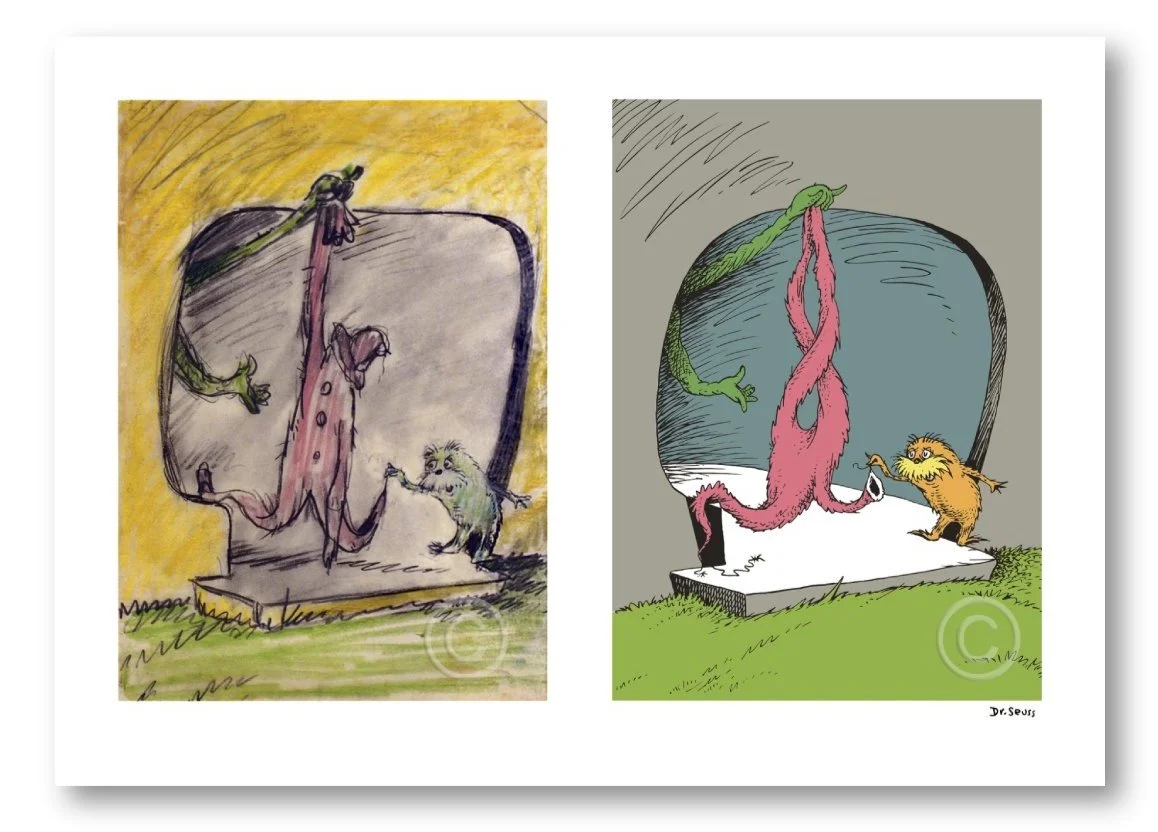The more that you read,
the more things you will know.
The more that you learn,
The more places you’ll go.
A New Illustration Art Release from
the Art of Dr. Seuss Collection
The More That You Read, The More Things You Will Know (Diptych)
Fine Art Pigment Print on Acid-Free Paper
Image Size: 9.5” x 14” (each), Paper Size: 13.5” x 32.5”
Limited Edition of 850 Arabic Numbers, 99 Patrons’ Collection, 155 Collaborators’ Proofs, 5 Hors d’Commerce, and 2 Printer’s Proofs
“Dr. Seuss’s message in this dynamic illustration seems clear: live life with a healthy dose of curiosity and you will be abundantly rewarded. ”
Ted Geisel (aka Dr. Seuss) was a shining example of this idea and never squandered a moment to learn something new.
His insatiable quest to get the most out of life through cultural and literary experiences started in early adulthood, most likely influenced by his mother’s early encouragement to read. In his early 20’s, Ted’s curiosity intensified while experiencing Paris and the pivotal Surrealist art movement. It continued as he trekked across thirty countries in the 1930’s, absorbing foreign cultures that would then go on to inform his work and guide his response to the world around him.
Geisel in his studio, La Jolla, California, 1949.
In this stunning illustration, Ted highlights that one’s curiosity and desire to learn can fuel life’s experiences, and such experiences can build exponentially upon themselves. As he wrote, “The more that you learn, the more places you’ll go.”
THE MORE THAT YOU READ,
THE MORE THINGS YOU WILL KNOW - Diptych
The More That You Read, The More Things You Will Know (Diptych)
Fine Art Pigment Print on Acid-Free Paper
Image Size: 9.5” x 14” (each), Paper Size: 13.5” x 32.5”
Limited Edition of 850 Arabic Numbers, 99 Patrons’ Collection, 155 Collaborators’ Proofs, 5 Hors d’Commerce, and 2 Printer’s Proofs
THE MORE THAT YOU READ,
THE MORE THINGS YOU WILL KNOW - single
The More That You Read, The More Things You Will Know (Single)
Fine Art Pigment Print on Acid-Free Paper
Image Size: 9.5” x 14”, Paper Size: 13.5” x 17”
Limited Edition of 2500 Arabic Numbers and 155 Collaborators’ Proofs
Curiosity and Experiences:
The Building Blocks of a Life Well Lived
“In the end, our own curiosity is on display in this drawing, reminding us that life can be more dynamic if we simply pursue knowledge with a passion reminiscent of Ted Geisel himself. ”
This particular illustration from I Can Read With My Eyes Shut! is a decisive reflection of what Ted held dear his entire life — the idea that curiosity is an essential building block for getting the best out of life’s experiences.
Ted brings together some of his most iconic characters and settings to make a powerful, visual statement about this central theme. Experiences can define us, Ted indicates, and reading is the key to unlocking it all.
Imagine spending an afternoon with the Cat in the Hat —on top of an elephant reminiscent of Horton — reading a book — while leisurely strolling through a Seussian landscape populated with Truffula-like Trees. That is an experience of a lifetime and an iconic reminder of the valuable ideas contained within each of these icons.
The More That You Read, The More Things You Will Know (Single) from I Can Read With My Eyes Shut!, published in 1978. I Call Them Thing One and Thing Two from The Cat in the Hat, published 1957. They Proved They Were Persons, No Matter How Small from Horton Hears a Who!, published 1954. I Am the Lorax, I Speak for the Trees from The Lorax published 1971.
The Diptych Concept Drawings
Ted Geisel drew each page for every Dr. Seuss book he wrote. What many people don’t realize is that for each final-line drawing, he would create multiple concept drawings leading up to the final published image.
The diptych works highlight the nuanced changes that would occur throughout the development process, and pair together Ted’s earliest stage pencil drawings with his final pen and ink drawings of the same scene. Look closely and see if you can identify the changes and ask yourself, why do you think he made these subtle adjustments? Remember, every mark an artist makes is there for a reason.
“Look closely and see if you can identify the changes and ask yourself, why do you think he made these subtle adjustments? ”
Do You Like Green Eggs and Ham? (Diptych)
Fine Art Pigment Print on Acid-Free Paper
Image Size: 10.75” x 14” (each), Paper Size: 14.25” x 32.5”
Limited Edition of 850 Arabic Numbers, 99 Patrons’ Collection, 155 Collaborators’ Proofs, 5 Hors d’Commerce, and 2 Printer’s Proofs
In Ted’s early pencil sketches, we see the frenetic energy of someone trying to work out his ideas as quickly as possible, almost as if he is going to lose the inkling if he doesn’t work fast enough. The remarkable outcome of such impulsive energy is that, in these tangled lines, he captures the entirety of a character’s personality.
Knox in Box. Fox in Socks. (Diptych)
Fine Art Pigment Print on Acid-Free Paper
Image Size: 14” x 11” (each), Paper Size: 17.5” x 26.5”
Limited Edition of 850 Arabic Numbers, 99 Patrons’ Collection, 155 Collaborators’ Proofs, 5 Hors d’Commerce, and 2 Printer’s Proofs
In the more refined pen and ink concept drawings, we see the nuanced changes that push the story forward. Ted’s tireless reworking of these drawings, in many cases over the course of an entire year, was an effort to get his characters and compositions to be more powerful, more insightful, and closer to the lessons he endeavored to convey. He would draw each page multiple times, beginning with the rough pencil sketches and evolving to the final pen and ink drawings. If unsatisfied, he would begin again.
A Thneed’s A Fine Something that All People Need! (Diptych)
Fine Art Pigment Print on Acid-Free Paper
Image Size: 14” x 10” (each), Paper Size: 17.5” x 24.5”
Limited Edition of 850 Arabic Numbers, 99 Patrons’ Collection, 155 Collaborators’ Proofs, 5 Hors d’Commerce, and 2 Printer’s Proofs



